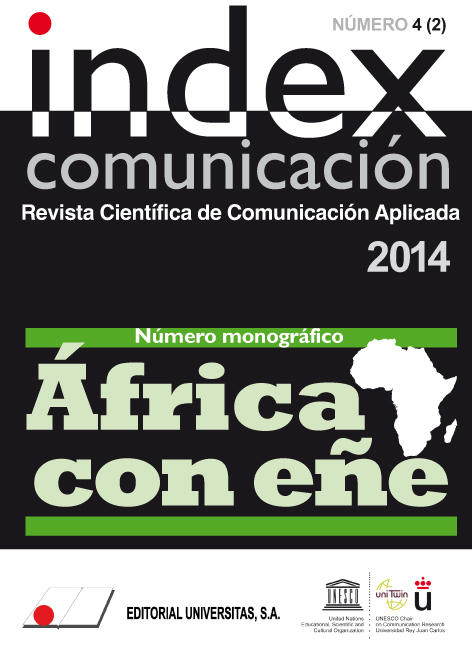Globalization and Spanish in the United States as a feature of identity
Keywords:
Globalización, español en los Estados Unidos, identidad americana.Abstract
Globalization is often linked with colonization and the spread of particular languages at the expense of others (see Cowen, 2001; Mufwene, 2005: 28; Calvet, 2006). The colonization of the Americas and the consequent expansion of the Spanish language in the American continent are attestations to this fact. While colonization historically belongs to the past, its offshoot, globalization continues in the present, especially in the United Staes where the Spanish language has taken on the form of a linguistic colonizer (Cancino, 2005); even though it’s not a reigning colonial power. Not that alone, the Spanish language has gradually become an integral feature of American identity. This article explores the status of Spanish in the world, its expansion in the U.S. and how the Spanish language has become an integral feature of American identity.Metrics
References
Azevedo, M. (2005): Introducción a la lingüística española. New Jersey, EE.UU: Pearson Education, Inc.
Bravo García, E. (2008): ‘El español internacional: Conceptos, contextos y aplicaciones’. Consultado el 20 de abril de 2014 desde: http://www.contrastiva.it/baul_contrastivo/dati/sanvicente/contrastiva/Norma%20est%C3%A1ndar%20y%20variaciones%20en%20espa%C3%B1ol/Bravo%20Garc%C3%ADa,%20El%20espanol%20internacional.pdf.
Bravo García, E. (2011): ‘El español internacional: valoración actual y usos específicos. Lengua y sociedad en el mundo hispánico’, en Language and Society in the Hispanic World. Vol. 27, pp. 49-71. Iberoamericana.
Caffarel Serra, C. (2008): ‘Estados Unidos: el presente y futuro del español’. Anuario del Instituto Cervantes. 2008, pp. 19-21. Consultado el 14 de abril de 2014 desde: http://cvc.cervantes.es/lengua/anuario/anuario_08/pdf/preliminares_01.pdf
Calvet, L. (2005): Synergie Chili, Globalización, lenguas y políticas lingüísticas. Santiago de Chile.
Cancino, R (2005): ‘El español y la globalización lingüística’, en Sociedad y discurso. Consultado en 14 de abril de 2014 desde: http://vbn.aau.dk/files/62985676/SyD7_cancino.pdf
Castells, M. (2010): ‘Globalización e identidad’, en Quaderns de la Mediterrània 14, pp. 254-262. Consultado en 20 de abril de 2014 desde: http://www.iemed.org/publicacions/quaderns/5/eCastells.pdf
Cowen, N. (2001): Global History. A Short Overview. Cambridge, Reino Unido: Polity Press.
Crystal, D. (2003): English as a Global Language. Cambridge, Reino Unido: University Press.
Dicker, S. J. (1996): Languages In America. A Pluralist View. Bilingual Education and Bilingualism. EE.UU: 10. Multilingual Matters Ltd.
Espinosa, A. Jr. (1975): ‘Problemas Lexicográficos del Español del Südoeste’, en El lenguaje de los Chicanos. Regional and Social Characteristics Used by Mexican Americans. Virginia, EE.UU.: Center for Applied Linguistics.
Frey, W. H. (2012): ‘Census Projects New “Majority Minority” Tipping Points’, en State of Metropolitan America, nº 60 de 64. Consultado el 22 de junio de 2013 desde: www.brookings.edu/research/opinions/2012/12/13-census-race-projections-frey
Furman, N.; Goldberg D. y Lusin, N. (2010): ‘Enrollments in Languages Other Than English in United States Institutions of Higher Education’. The Modern Language Association of America.
Goldman Sachs Strategy Research (2007): The Goldman Sachs Group, Inc.
Gómez Font, A. (2012): ‘Español neutro o internacional’. Consultado el 27 de julio de 2014 desde: http://www.fundeu.es/escribireninternet/espanol-neutro-o-internacional
Gutiérrez Ramírez, M. y Landeros Falcón, I. A. (2010): ‘Importancia del lenguaje en el contexto de la aldea global’, en Horizontes Educacionales, vol. 15, nº 1, pp. 95-107. Universidad del Bío Bío: Chillán, Chile. Consultado el 28 de junio de 2014 desde: http://redalyc.uaemex.mx/src/inicio/ArtPdfRed.jsp?iCve=97916218008
Huntington, S. P. (2004a): ‘The Hispanic challenge’ (versión electrónica), en Foreign policy. Consultado el 11 de marzo de 2004 desde: http://www.foreignpolicy.com/story/cms.php?story_id=2495
Huntington, S. P. (2004b): Who Are We? The Challenges to America’s National Identity. New York: Simon and Schuster.
Johnson, F. L. (2000): Speaking culturally: Language diversity in the United States. Thousand Oaks, CA: Sage Publications.
Lago, E. (2008): ‘Estados Unidos Hispanos’. CVC. 2008. Anuario del Instituto Cervantes, pp. 23-26.
Lago, E. (2013): ‘La literatura hispana se convierte en potencia cultural en EE.UU’. Consultado el 14 de marzo de 2014 desde: http://cultura.elpais.com/cultura/2014/01/23/actual
Lipski, J. (2004): ‘La lengua española en los Estados Unidos: avanza a la vez que retrocede’, en Revista Española de Lingüística, 33, pp. 231-260.
Lipski, J. (2010): ‘¿Existe un dialecto estadounidense del español?’ Consultado el 24 de junio de 2014 desde: congresosdelalengua.es/valparaiso/ponencias/america_len gua_espanola/lipski_john_m.htm
López García, Á. (2007): El boom de la lengua española. Análisis ideológico de un proceso expansivo. Madrid: Biblioteca Nueva.
Marcos Marín, F. (1994): ‘El español, lengua internacional. Ensayo: La lengua española, hoy (xix), en Boletín Informativo. Fundación Juan March, nº 239.
Mufwene, S. (2005): Globalization and the Myth of Killer Languages: What’s Really Going on? Perspectives on Endangerment. New York.
Ruiz Mantilla, J. (2008): ‘Más ‘speak spanish’ que en España. La fuerza del español’. Consultado el 14 de marzo de 2014 desde: elpais.com/diario/2008/.../1223244001_850215.htm
Saz, M. S.: ‘Lengua e identidad: el caso del español y el inglés en Estados Unidos’. Centro Virtual Cervantes. ACTAS xxxvi (AEPE) pp. 223-231. Consultado el 14 de abril de 2014 desde: http://cvc.cervantes.es/ensenanza/biblioteca_ele/aepe/pdf/congreso_36/congreso_36_30.pdf
Spolsky, B. (1999): ‘Second-language learning’, en J. Fishman (Ed.), Handbook of language and ethnic identity, pp. 181-192. Oxford: Oxford University Press.
Vargas Llosa, M (2010): ‘La lengua común’. Consultado en 24 de junio de 2014 desde: http://congresosdelalengua.es/valparaiso/inauguracion/vargas_llosa_mario.htm
Downloads
Published
How to Cite
Issue
Section
License
Authors who submit to this journal agree to the following terms:
Authors retain copyright and ensure the magazine's right to be the first publication of the work as licensed under a Creative Commons Attribution-NoComercial 4.0 International License that allows others to share the work with an acknowledgment of authorship of the work and the initial publication in this magazine, with no commercial purpose.
Authors can establish separate additional agreements for non-exclusive distribution of the version of the work published in the magazine (for example, to an institutional repository or publish it in a book), with an acknowledgment of its initial publication in this journal.
It allows and authors are encouraged to disseminate their work electronically (eg, in institutional repositories or on their own website) prior to and during the submission process, as it can lead to productive exchanges, as well as a citation more early and most of the published work (See The Effect of Open Access).















